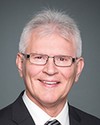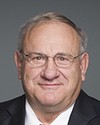Mr. Speaker, it is my privilege to rise again to speak to Bill C-18, an act to amend the Rouge National Urban Park Act, the Parks Canada Agency Act and the Canada National Parks Act.
Today, I am going to spend a bit of time talking about my riding in northern Alberta. I like to call my riding the promised land, as I have said a number of times. I am going to talk about a little piece of promised land in the northeastern corner of my riding, land that is now becoming part of the new reserve for the Little Red River Cree Nation. Gus Loonskin is the chief. I have not had the privilege of visiting that part of my riding yet. I have made arrangements to go there several times, but due to some unforeseen circumstances on two occasions, the meetings have been cancelled.
I have driven to the northernmost edge of my riding. it is a long four-by-four road into the communities. The chief thought better of my driving the road myself, although I am always up for an adventure. He said he would meet me in High Level and then things transpired and we never actually met, but one day I will make it up to the Little Red River Cree Nation and visit the communities of John D'Or Prairie, Fox Lake, and Garden River.
Garden River is within the boundaries of Wood Buffalo National Park, and that is precisely what this bill is about today. It proposes turning 37 square kilometres of land in Wood Buffalo National Park into a reserve for the Garden Creek community, which is part of the Little Red River band.
The Little Red River Cree Nation is made up of about 5,000 people in northern Alberta. It is about 200 kilometres south, maybe less, of the border with the Northwest Territories. At the end of June and beginning of July, there is nearly 24 hours of sunlight in northern Alberta. In the spring, people typically get a lot of work done because there are lots of hours of sunlight. After getting home from work, typically there is eight hours of sunlight left before people go to bed, so things get done at that time of the year. However, the inverse is true during December and January, when there are only a few hours of daylight. Typically it is light only from about nine o'clock in the morning until three or four o'clock in the afternoon. When there is snow on the ground, not much happens anyway, other than logging.
The Little Red River Cree Nation actually owns its own logging company, Little Red River Forestry Ltd. It owns a number of companies that operate in that part of the world and they are relatively successful. Having a population of 5,000 gives forestry companies in that area human resources to tap into. There is a significant amount of forestry that takes place in northern Alberta. There is also a significant number of other things that happen there.
Little Red River Cree Nation is also home to the Little Red River Wildland Firefighters Inc. Northern Alberta is a relatively sparsely populated part of the country and there are vast forests that people work in, such as loggers. There is also oil field development. There is a lot of wildlife as well. Managing forest fires is a big part of what is done in northern Alberta. The Little Red River Cree Nation is a definite part of that as well, because it has its own company that contracts to the Alberta government and the federal government to maintain the forests in the area.
From my research, this is part of Treaty No. 8 territory. Treaty No. 8 was signed in 1899, well over 100 years ago. Shortly after that, Wood Buffalo National Park was put in place to allow for a large buffalo herd to move freely. Interestingly, however, there was no buffalo herd there, so the park was created and the buffalo were transported from Wainwright, Alberta, which is about 900 kilometres south, and they were transplanted in Wood Buffalo National Park.
This leads to some concern today, because these bison have bovine TB. Even the local indigenous population does not hunt them because of the worries of the disease that happens to live in some of the bison. There is an ongoing concern about that.
Either way, whatever the case may be, at 47,000 kilometres, this is one of the largest, if not the largest, national parks in the country. It takes up the whole northeastern corner of Alberta. It is not a national park that a lot of people visit, because there are not a lot of roads to it. To get to this particular corner, people would have to fly in or drive in during the winter on a winter road. I believe that people can get there by taking a ferry down the river as well. For the most part, however, nobody drives in and out of that area on a regular basis. It is a significantly remote corner of the province. There is not a lot of industrial activity in the park, and therefore, there is no need for roads, and roads going to that corner of the province simply do not get built.
Since 1988 or maybe a little earlier, but for decades and nearly as long as I have been alive, they have been working on transferring this piece of land out of the park and into a reserve. This work has been ongoing.
I would also point out that there are other areas in my riding where people are waiting for a reserve. There is the Peerless Trout First Nation, which is probably about 300 or 400 kilometres south of the area that is in the bill. The people there are also waiting for their reserve. They have been promised land as well, and they are working tirelessly for their reserve.
This is a three-stage process. I have met with the band and council. They have shown me what is going on, and I have been able to advocate for them on these things. They have stage one and their own piece of land, which is now the reserve. They have built a health centre. They have their own fire station, and are building an education centre there as well. However, there are still stages two and three. They are looking forward to getting that completed.
This is an ongoing process with many levels of government dealing with it. There's the provincial government. Typically, all of the crown land in Alberta is managed by the provincial government. The provincial government has to sign off on it, which I believe it has. The local municipality also has interests in that area. It has a big road maintenance yard right inside that area. There has to be an agreement on how that is going to be managed as well. There are some hurdles that have to be stepped over in order to move forward.
There is the Lubicon Lake Band, which was missed by the Indian accountants who came through in the 1800s and therefore never got its own reserve. These people have been living there for hundreds of years, and they just happened to have been missed. It is fairly easy to see why. People can travel for hours and hours on the highway and see only bush. There is a sign at the beginning warning of there being no gas for 175 kilometres. People had better have a full tank of gas. The band also moves around depending on the time of the year, and has several camps on the edges of these lakes. They were missed when the allocation for reserve lands came out, and so they never had a reserve. However, we worked diligently for 20 years or so, and in 2010 the band got its first agreement on where the land would be.
As members can imagine, sometimes there can be a kerfuffle between neighbouring bands. One band may say that it is that band's traditional territory, and the other band may say the same. This is also the case up in northern Alberta where I represent. We are looking to see more progress on that. However, the basic outline has been nailed down, and I think that deal was signed in 2010 with the federal government, and we are continually working toward that.
It seems these land claim deals typically take years and years just to get everybody on the same page and get all the details hammered out. I know that the Lubicon Lake Band First Nation is definitely looking forward to having its own piece of promised land.
As we consider the bill, the Rouge park aspect of the bill has been talked about extensively and I understand that it affects a lot more people seeing as it is perhaps right in the centre of a big, sprawling metropolis, with many ridings that interact with it. I would emphasize that the land in the northern part of my riding, at about 37 square kilometres, is about half the size of the Rouge national park, so it is a significant piece of land. Perhaps there are not as many people who will be impacted by this piece of land, but for the livelihood and the way of life of the Lubicon Lake Band First Nation, those 5,000 people who live in northern Alberta, this will have a profound impact on their ability to develop that area and to build permanent structures there and be able to use the land in the method that they see fit. It is a fairly virgin piece of land as well. There has not been too much impact in terms of industrial activity, unlike the Rouge national park.
I will leave what I have to say about the Wood Buffalo National Park and the taking of the 37 kilometres out of the park. I think I have addressed it well. I know the people of Little Red River are quite excited about this new development, but it has been worked on for generations. Regardless of whether the federal government has recognized this as being their territory or not, they have been living there already and they are excited about it, but it is also a matter of fact because they already live there and are raising their families there.
I will move on to the Rouge national park, the piece of this bill that has had the most attention from members. I think we are starting to sound like a broken record, but I want to talk about the term “ecological integrity”. Coming from northern Alberta, one of the most beautiful places in this country, to put the term “ecological integrity” on the Rouge national park seems like a great irony. I mentioned northern Alberta where we are taking part of the Wood Buffalo National Park out. That is an area that has ecological integrity and it is easy to see how we can continue to manage that purely because there are not a lot of people who live in Wood Buffalo National Park. In fact, this is the only community that lives in Wood Buffalo National Park.
However, the Rouge national park has been lived in for thousands of years. Significant industrial activity has happened in that area. Currently there are highways, power lines, and pipelines that run through it. All of these things make our lives better. Highways allow us to travel at high speeds, 100 kilometres an hour, to get where we need to go. Pipelines bring natural gas that we use to heat our homes, so we need these things. There is no doubt about that. With regard to power lines, I have a cellphone on my desk right now that every day is charged up. Every night I charge it up and most of the MPs here could not survive without our cellphones. It is a bit of an understatement, we probably could survive. It is not like water or food, but the anxiety that I feel when my cellphone is not in my pocket and it is not readily available, or if the battery goes dead, is significant.
That example is about the power to charge up my cellphone every night. I guess it is a bit of an overstatement to say I cannot survive without it, but I think members understand what I mean, that the power is important.
That says nothing about the heat that it provides. I know in Alberta, my home is heated with natural gas but where I rent here in Ottawa, my home is heated with electricity. It is imperative that the electricity continues. In order for that to happen, we are going to need power lines and we are going to need pipelines. It is a great technological feat to see that each house in this country is heated by some form other than wood nowadays. It is much too easy. In fact, I think that is part of the problem, that we have forgotten what it is like to go out and chop wood, and bring it in to keep our homes warm. We have forgotten what it is like to have to store wood all year long in order to burn it throughout the winter.
Now if we are cold, we just go over and turn the thermostat up. We do not think too much of it past that. We do not think about all the power lines that it took, and we do not think about all the pipelines. We do not think about the big dam that is up in northern Quebec or Labrador or B.C. or wherever it is that generates the power that we get to use.
Right here in Ottawa, within sight of this building, there is a big power generation dam. We often drive by there and wonder what it is. That is what is powering our cellphones. That is what is heating homes. It is that kind of thing. These are the technological advances that humanity, because we have put our minds to it and co-operated together, has been able to make, to make all of our lives better.
When we say Rouge National Urban Park should have ecological integrity, it is a misnomer even just to insinuate that currently we do not have ecological integrity there in terms of it being a natural habitat. There is a lot of human impact that has happened there.
Second, if we are going to put that on there, Parks Canada has a definition for that, a “hands-off approach”, letting nature take its course. If a stream is going to erode away the dirt, exposing a pipeline, potentially causing a spill, we are just going to let that happen and we are going to have to move the pipeline. If that is a stream that erodes away the base around one of the power lines, we will have to just let that happen. We cannot take preventative action, which, in my thinking, would be the smart thing to do.
One of my towns in northern Alberta, the town of Whitecourt, is looking to become a city soon. Every time the census comes out, the residents look to see if they have made it over the 10,000 mark. If it makes it over the 10,000, it can apply to become a city. At this point, it is a town.
Just last year, it launched a project to divert the water from the river to some degree to prevent it from washing away big parts of the town. There is a big lumber mill and a big park, and things like that, down in the river valley. It was being threatened by the river eroding the bank away. Just in one year, 35 feet was lost off the bank of the river. The river was moving into town, basically. Big berms have been built in the river to divert the water, so the water does not hit the bank directly and erode it more.
That is the beauty of humanity's genius, the fact that we can see these problems, and we can undertake methods to divert the water or prevent the forest fire or all of these kinds of things.
To put the term “ecological integrity” on a place like Rouge park seems very counterintuitive to me. No matter how much this piece has to be in there, I do not think it was an appropriate term to be placed on the Rouge park.
That said, I see my time is winding to a close here. I would like to congratulate the people of Little Red River Cree Nation on their new reserve. I would like to thank the government for continuing the hard work that has been done over the last decades to get us to this point.







